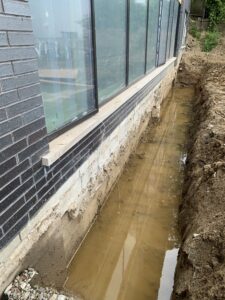Moisture control is one of the most crucial aspects of building a long-lasting, energy-efficient, and healthy custom home. Without proper planning, excess moisture can lead to mold, wood rot, and even structural damage. Here’s a breakdown of how to keep your home dry and protected—from the ground up.

Foundation & Basement: Keeping Water Out from Below
Common Problems:
- Groundwater seepage leading to basement flooding
- Humidity buildup causing mold and mildew
- Poor drainage contributing to foundation cracks
Best Practices:
✔ Install a perimeter drain system and use gravel backfill to direct water away.
✔ Apply a waterproof membrane to foundation walls for added protection.
✔ Use a sump pump with a backup system to remove excess water.
✔ Apply a waterproof membrane to foundation walls for added protection.
✔ Use a sump pump with a backup system to remove excess water.
Walls & Framing: Protecting the Home’s Structure
Common Problems:
- Rain infiltration through siding, windows, and doors
- Poorly sealed gaps allowing moisture into the walls
- Condensation buildup inside wall cavities
Best Practices:
✔ Use a weather-resistant barrier (WRB) to block water while allowing walls to breathe.
✔ Install flashing around windows, doors, and roof intersections to direct water away.
✔ In colder climates, consider an interior vapor barrier to prevent condensation inside walls.
✔ Install flashing around windows, doors, and roof intersections to direct water away.
✔ In colder climates, consider an interior vapor barrier to prevent condensation inside walls.
Roofing & Attic: Stopping Leaks & Condensation
Common Problems:
- Roof leaks leading to interior water damage
- Poor ventilation causing attic moisture buildup
- Ice dams forming in cold climates
Best Practices:
✔ Design the roof with adequate overhangs, gutters, and proper slope to direct water away.
✔ Ensure ridge and soffit vents are installed for proper attic ventilation.
✔ Use high-quality roofing materials and proper flashing to minimize leaks.
✔ Ensure ridge and soffit vents are installed for proper attic ventilation.
✔ Use high-quality roofing materials and proper flashing to minimize leaks.
Interior Moisture Control: Regulating Humidity Indoors
Common Problems:
- Everyday activities (cooking, showering, etc.) generating moisture
- High indoor humidity causing discomfort and mold growth
- Poor airflow trapping moisture in certain areas
Best Practices:
✔ Install a whole-home ventilation system (HRV/ERV) for fresh air exchange.
✔ Use bathroom and kitchen exhaust fans to remove humidity at the source.
✔ Invest in a dehumidifier or HVAC system with humidity control for year-round comfort.
✔ Use bathroom and kitchen exhaust fans to remove humidity at the source.
✔ Invest in a dehumidifier or HVAC system with humidity control for year-round comfort.
Why Moisture Management Matters
A well-designed custom home with proper moisture control will have:
✅ Better indoor air quality
✅ Increased energy efficiency
✅ Reduced maintenance and repair costs
✅ A longer lifespan with fewer structural issues
✅ Increased energy efficiency
✅ Reduced maintenance and repair costs
✅ A longer lifespan with fewer structural issues
If you’re planning a custom home and want to ensure it’s built to last, contact us today for expert guidance on moisture management and high-performance construction techniques.


